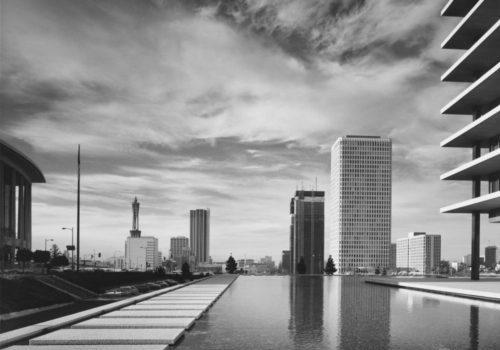The perfect gift for those obsessed with Mad Men chic is the small, smartly designed small survey of architectural images by Julius Shulman. The Getty Research Institute has put together this sweet little book from his photography archive in their special collections. Just under 5.5 x 6.5 inches, it is full of beautifully printed black and white images of Los Angeles taken between 1931 and 1986. The buildings were built between 1870 and 1981 and this disparate range of architectural styles is unified by Shulman’s single vision of presenting these achievements in the most ideal manner possible. It includes his most beloved images of the iconic “Case Study House #22” of 1960, in which two women sit inside the floor-to-ceiling window walls of a Pierre Koenig–designed house that seems to float like a spaceship over the light-spangled urban sprawl beyond. Despite the small format, the images are crisp and defined, yet with the depth that a nice block varnish gives black and white photography. The short essay is adequate as a primer to Julius Shulman and Los Angeles architecture, but honestly, this little book could have been so much more.
Lacking in this book is any reference to the fascinating and turgid politics of urban and suburban development in Los Angeles. Also lacking is analysis of the impact of the Shulman aesthetic on the marketing of Los Angeles and the California Dream, nor what elements comprised this dream. The messy back-story of the birth of this unique and uniquely modern metropolis is in distinct contrast to these beautiful, but superficial environmental portraits. Shulman’s gift was a pioneering and refined, but commercial vision that really helped his architect friends and clients like Charles Eames, Richard Neutra and John Lautner become the icons of modernity. These portraits are tributes to Man’s mastery over Nature and a hymn to the elegant math of modern engineering. But it is a vision that is mostly divorced from the emotional struggles of “progress”, save a lone image of two old, lonely victorian homes with the monolitic Union Bank rising behind it. One image in particular, “Case Study House #21” illustrates the quintessential fifties dream house with a couple enjoying life, though it actually looks a bit more like a Roy Lichtenstein illustration depicting alienation and could have served as the set model for the 2002 film, “Far from Heaven”, a tale exposing the hypocrisy of the rigid value system of that era. It is an inspiration for Mad Men, if there ever was one.
It does make some sense that this book is more of a marketing piece for Shulman as the publishers are part and parcel of the grand architecture of Los Angeles and the money behind it is old Los Angeles oil money. The Getty Research Institute is housed in the fabulous complex built by Richard Meier. A visit there is quite simply like being on Mount Olympus. One wonders if the staff would have the courage or the intellectual distance needed to really inject substance into a book of this kind. On the other hand, it is clearly not their intention to do so, though it would make this little reference book far more useful. This is a pocket reference book, a jewel one pulls out every now and then to pet and admire.
Review by Melanie Light
Julius Shulman’s Los Angeles
By Christopher James Alexander
Publisher: J. Paul Getty Museum; 1st edition (October 29, 2011)
J. Paul Getty Museum; 1 edition (October 29, 2011)
English
ISBN-10: 1606060791
ISBN-13: 978-1606060797
6.5 x 5.3 x 0.3 inches
















